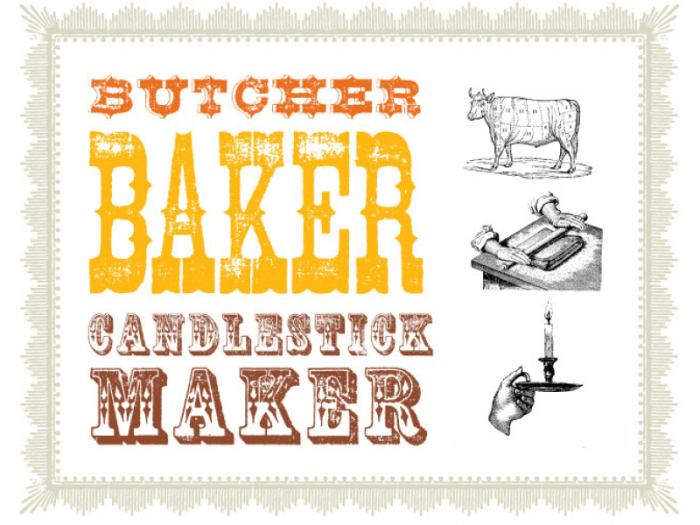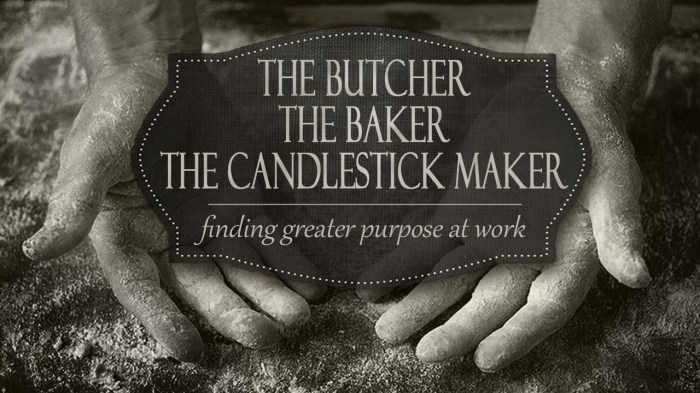Butcher baker candlestick maker riddle – The “butcher, baker, candlestick maker” riddle has captivated minds for centuries, with its enigmatic characters and perplexing premise. This enduring riddle has been passed down through generations, inspiring countless interpretations and cultural adaptations.
This comprehensive analysis delves into the historical origins, literary devices, and symbolic interpretations of the riddle. It explores its cultural variations, modern adaptations, and its continued relevance in popular culture and beyond.
Historical Context

The “butcher baker candlestick maker” riddle has a rich historical lineage, dating back to the Middle Ages. Its origins can be traced to oral traditions in Europe, where it was often used as a test of wit and memory.
The riddle has been recorded in written form since the 16th century, appearing in various collections of puzzles and riddles. One of the earliest known written versions appears in the “Book of Merry Riddles” (1565), where it is attributed to the Italian poet and scholar Francesco Berni.
Throughout history, the riddle has been used in a variety of contexts, including as a form of entertainment, a teaching tool, and a means of social interaction. It has been incorporated into folk tales, proverbs, and even religious texts.
Literary Analysis

The “butcher baker candlestick maker” riddle is a classic example of literary wordplay. It employs several literary devices, including:
- Alliteration: The repetition of consonant sounds at the beginning of words, such as “butcher,” “baker,” and “candlestick maker.”
- Metaphor: The use of a figurative comparison, such as the use of “candlestick maker” to represent a person who makes candles.
The riddle’s structure also contributes to its meaning. The repetition of the phrase “who is the” creates a sense of rhythm and suspense, while the final line provides a surprise twist.
The riddle can be compared to other literary forms, such as proverbs or nursery rhymes, which often use simple language and repetition to convey a moral or lesson.
Symbolic Interpretations
The characters and objects in the “butcher baker candlestick maker” riddle have been interpreted symbolically in a variety of ways.
- Butcher: Can represent violence, aggression, or the shedding of blood.
- Baker: Can represent nourishment, sustenance, or the creation of something new.
- Candlestick maker: Can represent light, knowledge, or the illumination of darkness.
These interpretations have evolved over time, reflecting the changing cultural and social contexts in which the riddle has been used.
The riddle can also be seen as a metaphor for social or economic relationships, with the butcher representing the upper class, the baker representing the middle class, and the candlestick maker representing the lower class.
Cultural Variations
The “butcher baker candlestick maker” riddle exists in different versions in different cultures.
- In some versions, the riddle includes additional characters, such as a tailor or a shoemaker.
- In other versions, the objects associated with each character vary, such as a knife for the butcher or a loaf of bread for the baker.
These variations reflect cultural differences in language, customs, and beliefs. For example, the inclusion of a tailor in some versions may reflect the importance of the clothing industry in those cultures.
The cross-cultural appeal of the riddle suggests that it taps into universal human experiences and themes.
Modern Adaptations: Butcher Baker Candlestick Maker Riddle

The “butcher baker candlestick maker” riddle has been adapted in a variety of modern contexts, including popular culture and advertising.
- In the 1960s, the riddle was featured in a popular children’s television show called “H.R. Pufnstuf.”
- In the 1990s, the riddle was used in an advertising campaign for the American beer company Miller Lite.
These adaptations have updated or reinterpreted the riddle’s meaning, making it relevant to new generations of audiences.
The continued relevance and popularity of the riddle demonstrate its enduring appeal as a timeless and entertaining wordplay.
Common Queries
What is the origin of the “butcher, baker, candlestick maker” riddle?
The exact origin is unknown, but it is believed to have emerged in Europe during the Middle Ages.
What are some common symbolic interpretations of the riddle?
The butcher represents death, the baker represents life, and the candlestick maker represents enlightenment.
How has the riddle been adapted in modern times?
It has been used in popular culture, such as in movies, TV shows, and advertising, often with updated or reinterpreted meanings.